

 
Establishment:
Building a Community

Growth
The Argyle Icelandic Settlement grew quickly. Eight families braved the
winter of 1881, 17 the next. Within 10 years the district was
settled.
Sigurdur Chistopherson acted as an immigration agent and made several
trips back to Iceland. He was so successful in encouraging many of his
fellow Icelanders to immigrate to his newly-adopted homeland that he
was nearly thrown into jail for his trouble. The Icelandic
Government had begun to realize that they were losing many of their
citizens to America, and did not take kindly to immigration agents
luring their people away. He persisted, and in 1893, he brought back
the largest group of Icelanders to come to Argyle at one time.
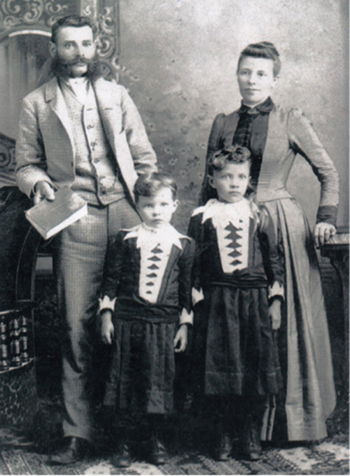
Sigurdur Christopherson (1848-1921).
By 1884, Skafti Aranson was able to report on behalf of the settlement:
"We have 650 cultivated acres, 260 head of cattle, 62 oxen, 70 pigs, 60
sheep, 9 work horses, 2 ponies, 2 colts, 6 mowers, 6 harnesses, 3
reapers, 2 binders, 1 threshing machine, 13 wagons, 23 ploughs, and 12
harrows. "
Post offices were soon open - one at Sigurdur Kristofersson's home -
Grund; one at Jon Olafson's home which he called Bru. Eventually the
settlement divided into two communities surrounding these homes. There
was also a small store at Grund.
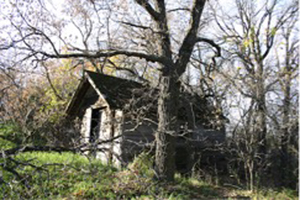
This building housed the Grund Post Office
for a time.
With crops in the field and food on the table, the settlers quickly
turned to the real purpose behind all the work and hardship;
establishing a better way of life for their families.
“Six schools were built by 1900; two Lutheran congregations were
established and a large church built to be used jointly by them until a
second could be built. The Ladies' Aid was organized; a lending library
established; a Good Morals Club, and later a Good Templars Society were
begun; three community halls were built which were the scenes of
picnics, plays, tombolas, and dances. The Argyle Brass Band played for
many of these dances and celebrations. In 1909, the Icelandic Women's
Suffrage Society was organized; and later a Young People's Club. There
were ball games played between the "Bush Rabbits" and the "Kangaroos"
at Bush Rabbit Point on the Gudnason farm near Little Baldur. “
*Come into our Heritage
Cultural Activities
The Icelanders brought with them their customs and beliefs many of
which have been incorporated into the general “Canadian” culture.
"Skoes", the soft slippers made from sheepskin, may be forgotten, but a
the lacy Icelandic shawl, may still be found on a cold day, as are
Icelandic sweaters from the wool of Icelandic sheep. While the sturdy
Icelandic ponies some brought have disappeared from the scene,
Icelandic sheep have recently made a comeback.
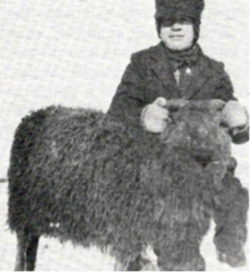
Herb Christopherson with Icelandic Ram.
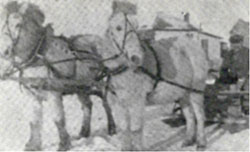
Icelandic ponies owned by Kristjan Isjeld.
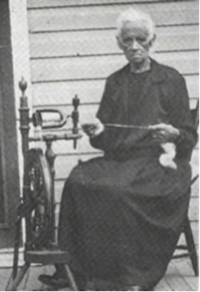
Sesselia Anderson spinning wool, about 1930
Love of books was a common element in all of the Icelandic Settlements.
Someone might read aloud while others worked at mending, knitting,
spinning and carding wool. Literary Societies developed, a tradition
begun in Iceland in the early 1800’s when they were in danger of losing
their language and customs to the influence of the Danish
masters. Given that, it was not uncommon to have a community
poet. In the Grund area that poet was Sigurbjorn Johansson, who would
write poems for the many special occasions of those early years. His
daughter Jakobina Johnson was to follow in his talented footsteps and
have several books of poetry published.
Health Care
In the early days, Hernit Kristofersson was much in demand with his
homeopathic medicines and cures and even after a doctor did settle in
Baldur, many families would still prefer to call on Hernit's help.
Peter Kristofersson's wife, Sigurveig Olafsdottir, was one of many
Midwives trained in Iceland who brought their skills to this new
land. She always carried a small needlepoint and leather satchel
filled with medicines and necessary tools for delivering babies.
Meeting Places
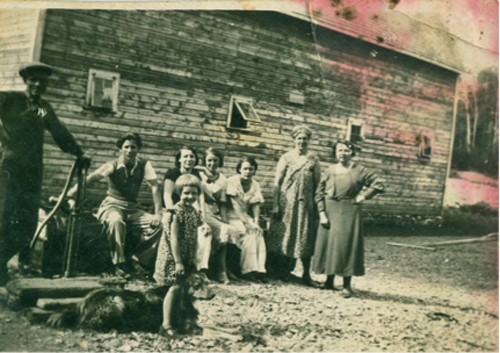
Skjaldbreid
Skjaldbreid Hall
"Skjaldbreid", (Broad Shield) was built in 1896, at the eastern end of
the oak bluff on Sigurdur Kristofersson's land. Initiated by the
Library Society, it was the scene of concerts, dances, plays, and
various celebrations. There the Good Templars met, the Ladies' Aid held
their tombolas; the Young People organized their club; and there were
Sunday School picnics.
Celebrations & Social Life
In pioneer times, people made their own entertainment. The hall was
busy in all seasons and for many purposes. Some of the more memorable
occasions have been recorded in “Come into our Heritage:
A 3-act play (in Icelandic) called "Skugasvein". was performed on a
cold winter night in 1897 to a packed hall. Admission was 25˘ for
adults, and 15˘ for young people.
On June 18, 1898 the wedding of Lara Arnason and Kris Thordarson were
wed at Frelsis and the guests then travelled to Skjaldbreid for a large
meal. A poem was written by Sigurbjorn Johansson (community poet) and
read aloud "to Lara and Kris on their wedding day".
A celebration was held Dec. 31, 1899, to welcome in the 20th century -
this was an all-night affair!
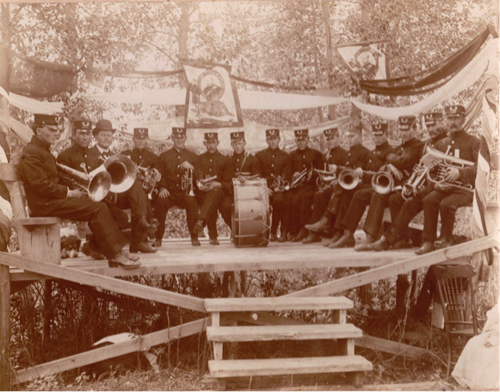
The Band
The silver wedding anniversary of four of its pioneer couples: Ami
Sveinson and Gudrun Jonsdottir; Skafti Arason and Anna Johannsdottir;
Kristjan Jonsson and Arnbjorg Jonsdottir; Sigurdur Kristofersson and
Caroline. Taylor took place on July 19, 1902. These couples had been
married in 1877, at Gimli.
In 1905, the 25th anniversary of the first homesteads filed, was the
occasion a celebration. On Wednesday, June 14, a special train brought
Icelanders from Winnipeg. Upon their arrival in Glenboro, buggies,
democrats, and wagons were waiting at the station to bring the visitors
to Skjaldbreid.
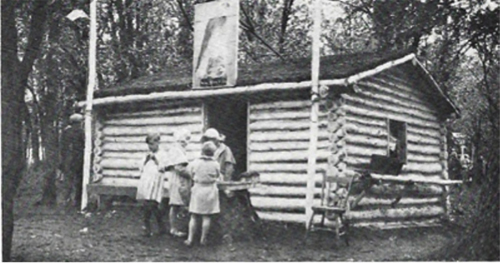
Log cabin built in 1931 to celebrate the 50th
anniversary of Icelandic
settlement.
50h anniversary celebration at Grund of the Icelandic settlement in
Argyle.
It is fitting that the last time Skjaldbreid was used as a hall was for
the 50th anniversary of the settlement in 1931. Once again a
large celebration was planned with picnic, flags flying, games,
singing, band music and speeches. A small log cabin with sod roof was
built in the Grund woods near Skjaldbreid - it was typical of the first
homes the pioneers built for themselves. Although the Sunday School
picnics continued on the site until the early 1940's, the days of the
hall were over.
The Argyle Hall
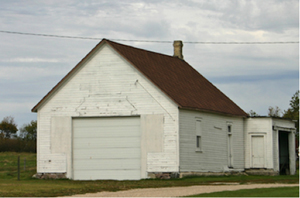
The Argyle Icelanders organized a "Good Etiquette Club"
(Sidabotafelagid) for the purpose of contributing to the proper
upbringing of their young men and women. That led, by the end of the
nineteen century, to the forming of a new organization - "The
Independent Order of Good Templars, Idunn Lodge No. 36".
The Good Templars held their early meetings and concerts at Skjaldbreid
and in 1903, bought a parcel of land near Frelsis Church where they
built a Good Templars Hall. The Good Templars were active for many
years, engaged in what today were would call acts of charity and
community building.
In 1905, the building was enlarged, making it suitable for all
occasions and gatherings. The new kitchen and dining room would make it
easier to serve meals and lunches. At dances in those early days,
everyone sat down at tables in the dining room to eat their lunch while
the band took its break.
The stage was featured a fine roll curtain with red and gold scroll
surrounding a large scenery - hand painted by Fred Swanson, a painter
and decorator in Winnipeg.
Church conventions, fowl suppers, minstrel shows, tombolas, concerts,
dances, and Ladies' Aid bazaars were some of the many events held at
Argyle Hall.
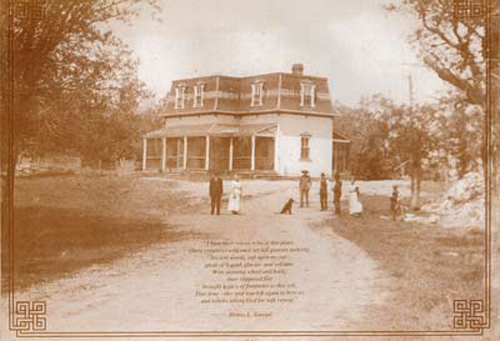
“Grund, " the Sigurdur and Caroline Christopherson home. The site of
the Grund post office until the 1920's. (ww.christpherson.net)
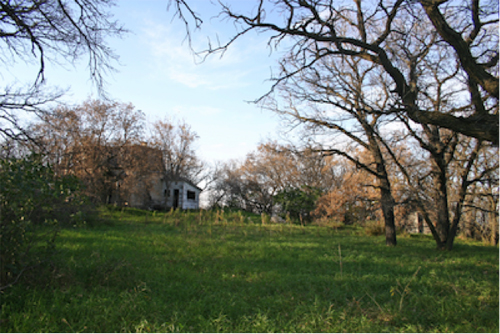
The Grund site in 2011
Frelsis (Liberty)
Frelsis was more than a place of worship, it was the heart of the
community.
Although it took some time for the community to build a church, many
settlers held scriptural readings each evening in their homes and
Layman services and Sunday School classes were in homes as well. By
1884, the "Frikirkja" congregation was established and Layman services
continued in homes until they could be held in the newly built Hecla
and Bru Schools.
On July 26, 1885, a new congregation, 'Frelsis' (Liberty). was formed -
to serve the western part of the settlement. Rev. Jon Bjarnason served
the congregation with periodic visits.
At a joint meeting in 1888, the Bru and Grund congregations agreed to
build a church.
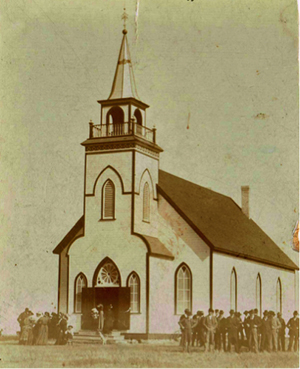
Grund Frelsis Lutheran Church. Built in 1899 by the
pioneers.
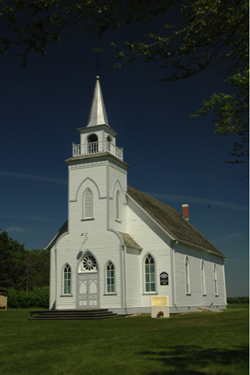
Photo from the Baldur Website
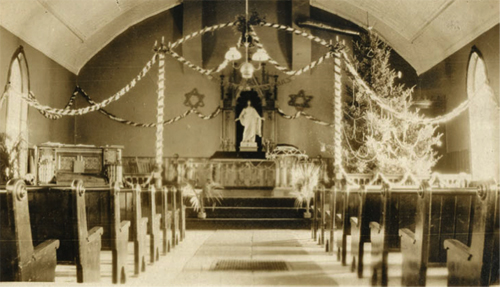
Interior of Grund Church - www.cristopherson.net
Fundraising began with the Ladies' Aid, organized in 1885, contributing
the first $200. Two acres of land were bought for $10 from Sigurjon
Snidal. Carpenters, Byring Hallgrimson and Ami Sveinson, with the help
of volunteer labour, had the building completed by June. Hafsteinn
Pjetursson, recruited from Iceland, served the district until
1893.
Over the years there have been many changes to the original design.
A belfry with steeple to house a 500 pound copper bell was added in
1896. Byring Hallgrimson hand carved the pulpit in his own kitchen and
painted it soft shades of cream and orchid with touches of metallic
gold trim. Coal-oil chandeliers were donated; then later converted to
electricity. A two manual "Doherty" organ was purchased in 1911.
Originally there were steps on both sides of the altar platform that
led up to a higher platform behind the altar – for the organ and the
choir. This was replaced one low wide platform.
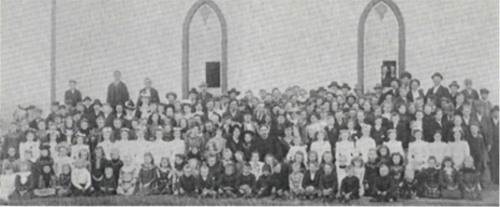
Congregation attending a confirmation service. Grund Church around
1900. Sera Jon Clemens, Minister.
A minister's house was built just north and west of the church.
Johannes Sigurdson donated two acres of land to the district to be used
as a cemetery – about a kilometre to the east.
The 50th anniversary of Frelsis Congregation was marked in 1935 with a
celebration including a short service in the church, and a lunch for a
large crowd in Argyle Hall.
In 1965, with membership down, it was decided that Frelsis congregation
merge with Immanuel in Baldur. By this time Frelsis was the
oldest-standing Icelandic Lutheran Church in Canada. Its members wanted
to preserve the church on its original site in memory of the pioneers.
Under the guidance of Rev. Robertson, a committee of Frelsis members be
set up to decide the fate of the church. Encouraged by many interested
people, the committee requested that the Manitoba Government have the
church declared an historic site. This request was granted. At a
special church service on Sunday, Sept. 15, 1974, the Government of
Manitoba assumed custodianship of Frelsis, to maintain it as a memorial
to the Icelanders who contributed so much to this province and to this
country.
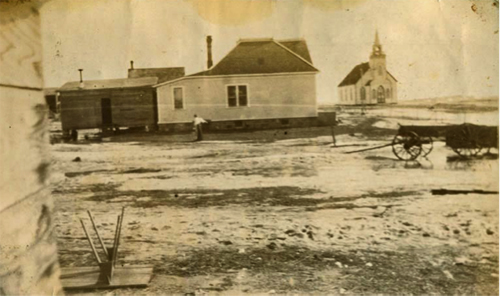
Photo from www.cristopherson.net
Quote from the "Baldur Gazette", April 27, 1905:
"Easter Sunday service in the Grund Lutheran Church was beyond doubt
the most largely attended country service throughout the province. The
service was held from 12 noon until 3 p.m., conducted by the Rev.
Fredrick Hallgrimson, pastor. 126 rigs, of which one-half were
democrats and wagons, were counted - making an estimated attendance of
fully 600 people. The church was crowded to overflowing, many standing
outside. The Easter service was made the occasion for the confirmation
of a large class of candidates, 33 in number, who were duly received
into full church membership. A number of children were also baptized.
Following the service, there was a celebration of the Holy Com-
munion."
Bru
While Grund was the focal point of the western part of the Icelandic
settlement, the eastern portion of the region became identified as Bru.
This started with the establishment of a post office at Jon Olafsson's
home. It was named after the Icelandic word for bridge. The Olafsson
home, later Albert Oliver's home, was near the bridge on Oak Creek.
A school also of that name was established s early as 1885. The first
school building was on SE 16-6-13, the homestead of Bjorn Jonsson. In
1897,it was moved to the northwest corner of SW 11-6-13. This building
served until 1921, when it was replaced by a new school on the
northwest corner of 11-6-13.
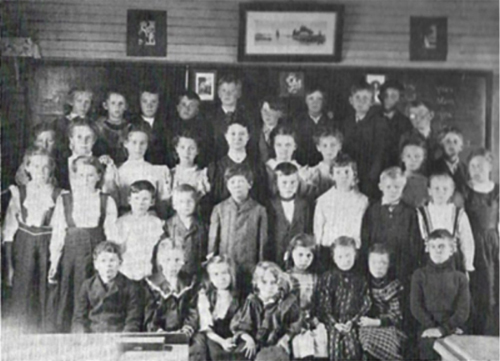
Class at Bru School, taken in 1906 or 1907
Frikirkja Church (Bru)
The two congregations of Frikirkju (Bru) and Frelsis (Grund) worked
together in harmony for over 20 years and shared the same church
building.
Then the members of Bru Congregation decided on the need for a church
closer to their homes. In 1910 called Frikirkju Lutheran Church was
built on southeast corner of 21-6-13, with Jon Olafson of Glenboro as
head carpenter. The building was composed of three sections: the main
part, the east wing for the choir, organ and minister's room, and the
altar portion. Beautiful stained glass windows adorn the entire
building. In the book, "Lutherans of Canada", Dr. V.J. Eylands has
written, "This is a beautiful church with a seating capacity of around
200, and was valued at the time of construction at about $5,000. The
beautiful furnishings of the church and its very fine liturgical floor
plan have lead it to be described by many visitors as the most
beautiful country church they have seen."
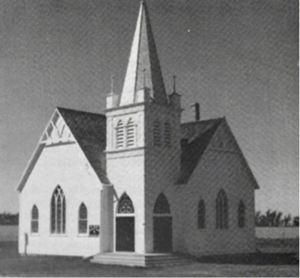
Frikirkja at Bru
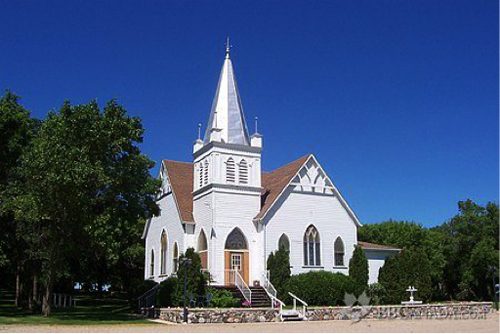
Café Bru – Frikirkja Church in it’s new location, and
with a new
purpose.
Bru Lutheran Ladies' Aid, 1895-1981
On June 13, 1895 several ladies of the Frikirkju Church congregation
met to organize the Bru Ladies' Aid.
Each lady paid a 25 cent fee to belong to the society. Their first big
project was to buy the communion ware for the church then in use. Their
fundraising efforts contributed to the furnishing the new church and
later the Bru Hall, as well as aiding various charities.
They were able to purchase all the beautiful oak pews and most of the
furnishings for the Bru Church.
In 1913, the ladies formed the "Memorial Flower Fund" which for
decades supported many useful projects, such as redecorating the
church, setting up a steel fence around the graveyard and helping the
needy.
Bru Hall
The Bru Hall was built on the northwest corner of NE 16-6-13. The land
was provided by Albert Oliver for the sum of $1.00. The deed for
the land was dated April 27, 1898. The Bru Ladies' Aid records that it
met in the Bru Hall on May 18, 1898. It was also used by other
organizations such as the Young People's Society, Literary Society,
Dorcas Society, and for other public functions such as dances,
receptions, plays, fowl suppers, showers, card parties and dinners for
synod conventions. For many years the Bru Hall was the centre of
activities for the district.
The hall was finally closed down in the
1960's.
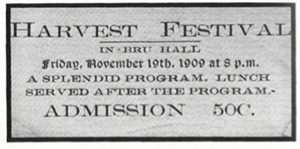
Bru Cemetery
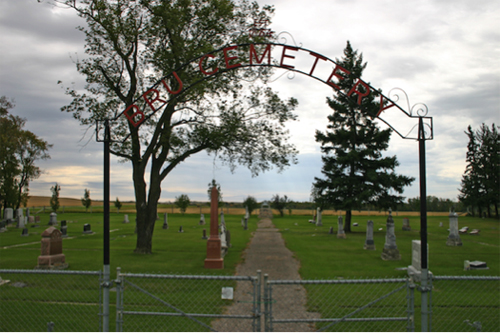
The Bru Cemetery was established in 1884, on the northeast corner of NE
16-6-l3. A one-acre plot was donated by Jon Olafson (Albert Oliver's
grandfather). The cemetery is still being kept in good condition. In
1972, a fund was started - to which people with relatives buried there,
made contributions. The interest earned by this fund goes toward the
maintenance of the cemetery.
The Dorcas Society of Bru
The Dorcas Society was formed in early 1918, a group of young women,
who organized for the purpose of making money to do good works. The
annual fee was set at 50˘ per member.
They raised money in these ways: they sponsored dances at Bru Hall; had
whist drives, bazaars, tombolas, and barn dances in the area; annually
took over the fruit stand at the Cypress River Fair; put on and
sponsored plays which were shown at Bru, Glenboro and Greenway, the two
most popular being "Dust of the Earth" and "Eyes of Love"; and they put
on minstrel shows.
They bought wool and made socks and mitts to send to the soldiers
overseas. They made wool comforters for needy families. They gave
liberally to the church, the patients of Ninette Sanatorium, Christmas
gifts to the elderly and bed-ridden. Wherever there was a need the
Dorcas Society would help if possible.
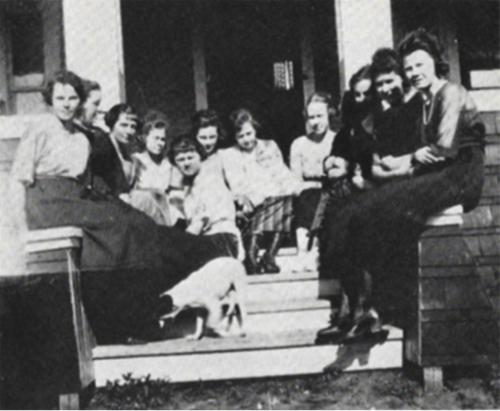
Some members of the Dorcas Society of Bru. Thorbjorg
Jonsson, Gudny
Sigurdson, Villa Anderson, Lauga Helgason, Miss Olson, Josie Anderson,
Svava Stefanson with Ester on Knee, Steinlaug Gudnason, He/ga Jonsson,
Alice Anderson, Clara Josephson.
The fellowship strengthened the bonds of friendship throughout the
lives of these fine young women.
EXCERPTS FROM THE BALDUR GAZETTE
"Approximately 100 invited guests were right royally entertained
Tuesday night, at the magnificent country residence of Mr. and Mrs.
Hannes Sigurdson, of the district. Speeches were delivered, songs and
duets rendered, the Argyle Band played, and in general, the evening was
spent in having a jolly good time. During the evening, the genial host
and hostess were presented with a beautiful solid silver tea service."
Nov. 25, 1915 - "The 5th anniversary service of the Lutheran Church at
Bru was celebrated on Friday, Nov. 19, in the church at 3 p.m. A good
program of songs and speeches was rendered, the executive having been
fortunate enough to secure Miss Oliver, a noted singer of Winnipeg, to
take part. After the concert, all adjourned to Bru Hall, where a
splendid supper was served. No admission fee was charged, but a
collection was taken, which amounted to $88.
"Rev. Mr. Hallgrimson's three congregations, have presented him with a
motor car. This is treating a minister in the right way. The members of
a congregation like to be visited by their pastor and this gives
facility for the maximum amount of visiting among his parishioners."
April 8, 1909 - "The concert and dance held in the Bru Hall on the
29th, under the auspices of the Argyle Band to commemorate the 4th
anniversary of their establishment, was pronounced success. The first
item on the list was the national Anthem played in harmony with a
prelude specially composed for the occasion by the able bandmaster Mr.
A. Oliver…“
Aug. 15, 1918 - "Icelandic Celebration - Aug. 2 is the national day of
Iceland. The day was celebrated at Bru in Anderson's grove under the
auspices of the Ladies' Aid of the district. The weather was fine and
the people gathered there in large numbers. A platform was erected in
the grove and a well-selected program was arranged. Reeve Johnson was
in the chair and conducted the program in his usual style. Rev. B.B.
Jonsson of Win- nipeg gave a stirring address. Arni Sveinson delivered
a splendid message. B. Walterson recited a poem composed by himself and
made a few remarks. The Argyle Band entertained at intervals. The
sports proved very interesting. The proceeds netted $127.30 for the
Overseas Club. "
 
|
|